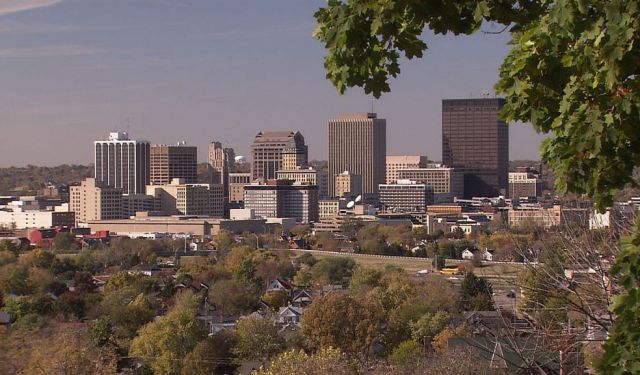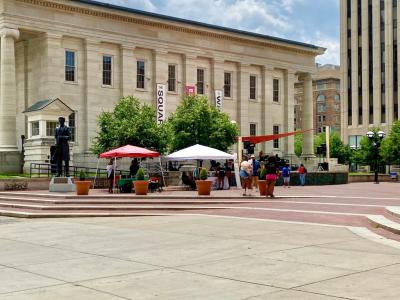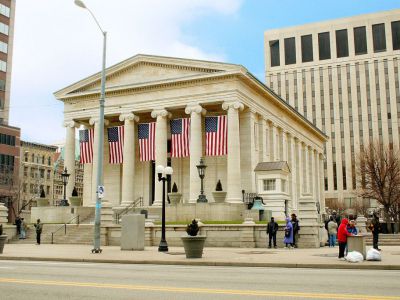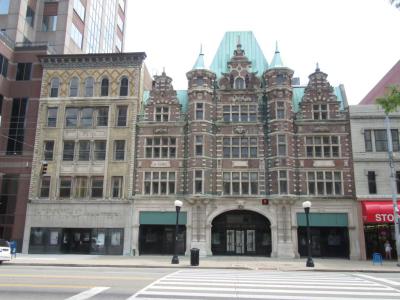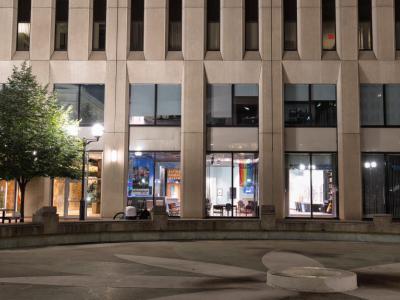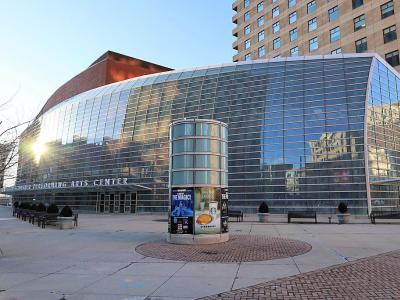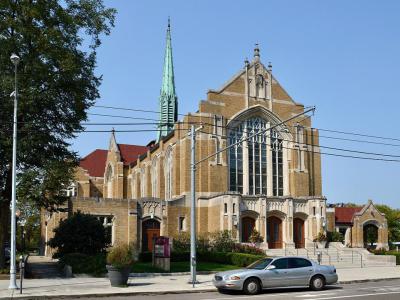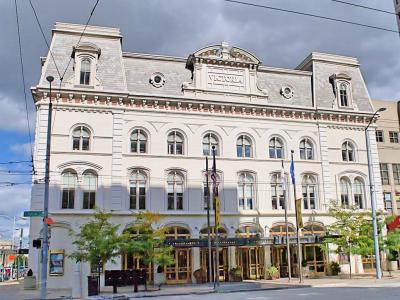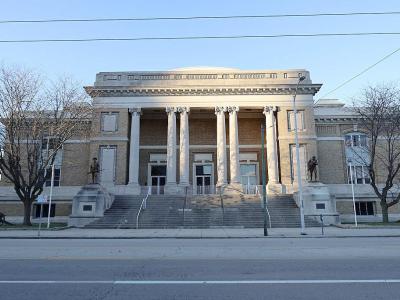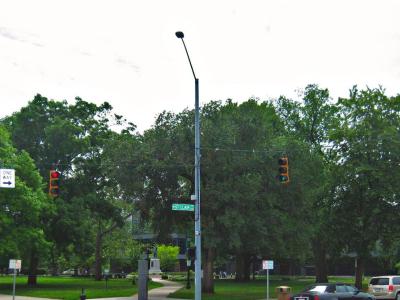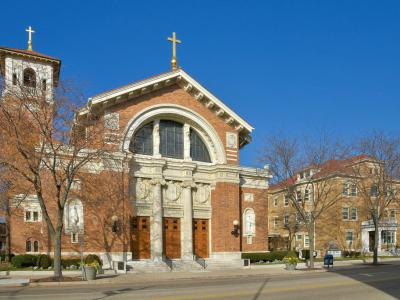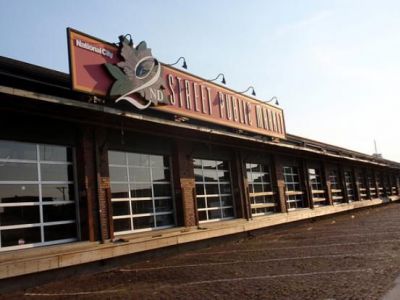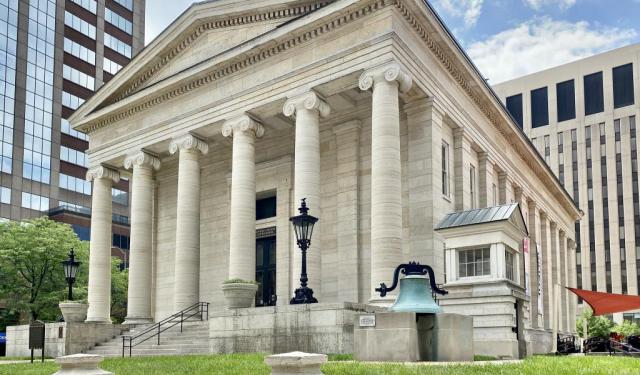Dayton Introduction Walking Tour (Self Guided), Dayton
Dayton, Ohio, often called the "Gem City" (for no apparent reason), is also known as the "Birthplace of Aviation" for being the hometown of the Wright brothers, inventors and builders of the first practical airplane. Additionally, Dayton is colloquially referred to as "Little Detroit" for its significant role as a Midwestern manufacturing center.
The original settlement along the Great Miami River was founded in 1796 by 12 settlers known as the Thompson Party. It was incorporated in 1805 and chartered as a city in 1841, named after Jonathan Dayton, a captain in the American Revolutionary War and a Founding Father, who signed the US Constitution and owned a significant amount of land in the area.
In 1827, construction on the Dayton–Cincinnati Canal significantly contributed to Dayton's economic growth. Historically a hub of innovation, the city was home to many inventors, most notably the Wright brothers and Charles Kettering, making it a leading city for patents per capita by the 1890s. Dayton later developed an industrialized economy and saw significant business growth from inventions like the first mechanical and electric cash registers as well as the Dayton Project, a branch of the larger Manhattan Project (developing early atomic bombs).
In the late 20th century, Dayton's businesses diversified into a service economy. The Downtown expansion started in the 2000s has helped revitalize the city and encourage its growth.
Today, Dayton's historical canvas stretches across various sites that narrate the tale of its evolution. Courthouse Square Park, located in the heart of downtown, is a vibrant public space often bustling with community events and activities.
Nearby stands the Montgomery County Courthouse, a majestic structure showcasing impressive architectural details. This courthouse, coupled with the Dayton Arcade-a beautifully restored complex that merges culture, dining, and residential spaces-provides a glimpse into the city's past and its adaptive reuse for modern needs.
For those who appreciate outdoor spaces, Cooper Park offers a serene environment right in the city center. It also features the Natalie Clifford Barney Historical Marker, commemorating the influential Dayton-born writer and playwright. Moreover, the Second Street Public Market is a must-visit spot for locals and visitors alike, offering fresh local produce, artisan goods, and a warm, welcoming atmosphere.
As a city that cherishes its past while continuously looking forward, Dayton invites you to explore its historic streets, engage with its vibrant community, and discover the landmarks that make it unique. Take this self-guided walk and let your journey through this remarkable city begin!
The original settlement along the Great Miami River was founded in 1796 by 12 settlers known as the Thompson Party. It was incorporated in 1805 and chartered as a city in 1841, named after Jonathan Dayton, a captain in the American Revolutionary War and a Founding Father, who signed the US Constitution and owned a significant amount of land in the area.
In 1827, construction on the Dayton–Cincinnati Canal significantly contributed to Dayton's economic growth. Historically a hub of innovation, the city was home to many inventors, most notably the Wright brothers and Charles Kettering, making it a leading city for patents per capita by the 1890s. Dayton later developed an industrialized economy and saw significant business growth from inventions like the first mechanical and electric cash registers as well as the Dayton Project, a branch of the larger Manhattan Project (developing early atomic bombs).
In the late 20th century, Dayton's businesses diversified into a service economy. The Downtown expansion started in the 2000s has helped revitalize the city and encourage its growth.
Today, Dayton's historical canvas stretches across various sites that narrate the tale of its evolution. Courthouse Square Park, located in the heart of downtown, is a vibrant public space often bustling with community events and activities.
Nearby stands the Montgomery County Courthouse, a majestic structure showcasing impressive architectural details. This courthouse, coupled with the Dayton Arcade-a beautifully restored complex that merges culture, dining, and residential spaces-provides a glimpse into the city's past and its adaptive reuse for modern needs.
For those who appreciate outdoor spaces, Cooper Park offers a serene environment right in the city center. It also features the Natalie Clifford Barney Historical Marker, commemorating the influential Dayton-born writer and playwright. Moreover, the Second Street Public Market is a must-visit spot for locals and visitors alike, offering fresh local produce, artisan goods, and a warm, welcoming atmosphere.
As a city that cherishes its past while continuously looking forward, Dayton invites you to explore its historic streets, engage with its vibrant community, and discover the landmarks that make it unique. Take this self-guided walk and let your journey through this remarkable city begin!
How it works: Download the app "GPSmyCity: Walks in 1K+ Cities" from Apple App Store or Google Play Store to your mobile phone or tablet. The app turns your mobile device into a personal tour guide and its built-in GPS navigation functions guide you from one tour stop to next. The app works offline, so no data plan is needed when traveling abroad.
Dayton Introduction Walking Tour Map
Guide Name: Dayton Introduction Walking Tour
Guide Location: USA » Dayton (See other walking tours in Dayton)
Guide Type: Self-guided Walking Tour (Sightseeing)
# of Attractions: 11
Tour Duration: 2 Hour(s)
Travel Distance: 2.4 Km or 1.5 Miles
Author: DanaOffice
Sight(s) Featured in This Guide:
Guide Location: USA » Dayton (See other walking tours in Dayton)
Guide Type: Self-guided Walking Tour (Sightseeing)
# of Attractions: 11
Tour Duration: 2 Hour(s)
Travel Distance: 2.4 Km or 1.5 Miles
Author: DanaOffice
Sight(s) Featured in This Guide:
- Courthouse Square Park
- Montgomery County Courthouse
- Dayton Arcade
- Dayton International Peace Museum
- Benjamin and Marian Schuster Performing Arts Center
- First Baptist Church
- Victoria Theatre
- Dayton Memorial Hall
- Cooper Park and Natalie Clifford Barney Historical Marker
- St. Joseph Parish Church
- Second Street Public Market
1) Courthouse Square Park
Courthouse Square Park is a central outdoor entertainment venue located downtown Dayton, Ohio. Since its dedication in 1974, the square has become a prominent gathering spot, earning a reputation as "the place to see and be seen." The park's location in the heart of the city makes it a focal point for community activities and events.
During the summer months, Courthouse Square comes alive with lunchtime vendors, offering a variety of food options for those working or visiting downtown. Additionally, a weekly farmers market during the growing season provides fresh local produce and goods, creating a vibrant and bustling atmosphere.
Courthouse Square is also a versatile venue open to any organization or individual wishing to host events. Nonprofit groups frequently use the space to promote upcoming events or conduct fundraisers, taking advantage of the high visibility and foot traffic in the area. Throughout the year, the square hosts a diverse array of events, including concerts, special events, noontime gatherings, and various fundraisers, making it a dynamic and lively public space.
A notable feature of Courthouse Square Park is the 11-foot-tall bronze sculpture of a beardless Abraham Lincoln. This statue commemorates Lincoln's speech in Dayton on September 17, 1859, delivered on the steps of the Old Court House. The sculpture serves as a historical landmark, reminding visitors of the city's rich history and Lincoln's connection to Dayton.
During the summer months, Courthouse Square comes alive with lunchtime vendors, offering a variety of food options for those working or visiting downtown. Additionally, a weekly farmers market during the growing season provides fresh local produce and goods, creating a vibrant and bustling atmosphere.
Courthouse Square is also a versatile venue open to any organization or individual wishing to host events. Nonprofit groups frequently use the space to promote upcoming events or conduct fundraisers, taking advantage of the high visibility and foot traffic in the area. Throughout the year, the square hosts a diverse array of events, including concerts, special events, noontime gatherings, and various fundraisers, making it a dynamic and lively public space.
A notable feature of Courthouse Square Park is the 11-foot-tall bronze sculpture of a beardless Abraham Lincoln. This statue commemorates Lincoln's speech in Dayton on September 17, 1859, delivered on the steps of the Old Court House. The sculpture serves as a historical landmark, reminding visitors of the city's rich history and Lincoln's connection to Dayton.
2) Montgomery County Courthouse
The Montgomery County Courthouse stands as a remarkable example of Greek Revival architecture in the United States. Built in 1847, this historic limestone building is located at the prominent intersection of Third and Main streets. Its design draws inspiration from the Temple of Hephaestus in Athens, Greece, a structure dating back to the 5th century BC, known for its Doric order and classical simplicity.
The architectural plan of the Montgomery County Courthouse mirrors the traditional Greek temple layout, featuring a high-ceiling vestibule leading to a center hall that culminates in a grand rotunda and elliptical courtroom. This layout not only pays homage to ancient Greek architectural principles but also provides a dignified and imposing setting appropriate for a courthouse.
The courthouse's design was influenced by Dayton citizen Horace Pease, who advocated for using the Temple of Theseus in Athens as a model. The Montgomery County Commissioners agreed with Pease's suggestion and commissioned architect Howard Daniels of New York to draw up the plans. Daniels successfully captured the essence and aesthetic beauty of the ancient Greek temple, resulting in a structure that remains a pinnacle of Greek Revival style in American architecture.
Recognized for its historical and architectural significance, the Montgomery County Courthouse was added to the National Register of Historic Places on January 26, 1970.
The architectural plan of the Montgomery County Courthouse mirrors the traditional Greek temple layout, featuring a high-ceiling vestibule leading to a center hall that culminates in a grand rotunda and elliptical courtroom. This layout not only pays homage to ancient Greek architectural principles but also provides a dignified and imposing setting appropriate for a courthouse.
The courthouse's design was influenced by Dayton citizen Horace Pease, who advocated for using the Temple of Theseus in Athens as a model. The Montgomery County Commissioners agreed with Pease's suggestion and commissioned architect Howard Daniels of New York to draw up the plans. Daniels successfully captured the essence and aesthetic beauty of the ancient Greek temple, resulting in a structure that remains a pinnacle of Greek Revival style in American architecture.
Recognized for its historical and architectural significance, the Montgomery County Courthouse was added to the National Register of Historic Places on January 26, 1970.
3) Dayton Arcade
The Dayton Arcade is a historic and architecturally significant complex situated in the heart of Dayton. Comprising nine interconnected buildings, the Arcade was constructed between 1902 and 1904. The visionary behind this project was Eugene J. Barney of the Barney & Smith Car Company, who aimed to create a state-of-the-art facility equipped with the latest innovations of the time, such as elevators, a power plant, and a cold-storage plant. The design of the Arcade was entrusted to architect Frank M. Andrews, who also designed many of NCR's factory buildings and the American Building at Third and Main Streets in Dayton.
A standout feature of the Dayton Arcade is its glass-domed rotunda, which measures 70 feet in height and 90 feet in diameter. This impressive structure is adorned with detailed carvings that celebrate Ohio's natural and agricultural heritage, including oak leaves, acorns, grains, ram heads, wild turkeys, and cornucopias filled with local produce. The rotunda is encircled by two balconied upper floors that overlook the central enclave, creating a grand and open interior space.
The great dome is perhaps the most intriguing architectural feature of the Dayton Arcade. Unlike traditional rotundas with classical detailing, this dome incorporates elements that reflect Ohio's identity. The decorative elements include colorful turkeys, festoons of oak leaves and acorns, and garlands of grain, all emphasizing the state's rich natural and agricultural resources.
The Arcade's architectural style varies across its different facades. The most notable building fronts are on Third Street, designed in the Flemish façade style, reportedly inspired by a guildhall in Amsterdam, Netherlands, and featuring old Dutch architectural elements. In contrast, the facades on Fourth Street and Ludlow Street are rendered in the Italian Renaissance Revival style, with the Commercial Building prominently anchoring the corner of the lot. This blend of architectural styles contributes to the complex's unique and historically rich character.
A standout feature of the Dayton Arcade is its glass-domed rotunda, which measures 70 feet in height and 90 feet in diameter. This impressive structure is adorned with detailed carvings that celebrate Ohio's natural and agricultural heritage, including oak leaves, acorns, grains, ram heads, wild turkeys, and cornucopias filled with local produce. The rotunda is encircled by two balconied upper floors that overlook the central enclave, creating a grand and open interior space.
The great dome is perhaps the most intriguing architectural feature of the Dayton Arcade. Unlike traditional rotundas with classical detailing, this dome incorporates elements that reflect Ohio's identity. The decorative elements include colorful turkeys, festoons of oak leaves and acorns, and garlands of grain, all emphasizing the state's rich natural and agricultural resources.
The Arcade's architectural style varies across its different facades. The most notable building fronts are on Third Street, designed in the Flemish façade style, reportedly inspired by a guildhall in Amsterdam, Netherlands, and featuring old Dutch architectural elements. In contrast, the facades on Fourth Street and Ludlow Street are rendered in the Italian Renaissance Revival style, with the Commercial Building prominently anchoring the corner of the lot. This blend of architectural styles contributes to the complex's unique and historically rich character.
4) Dayton International Peace Museum
The Dayton International Peace Museum stands as a beacon of nonviolence and peace education. Established as the second peace museum in the United States, following The Peace Museum in Chicago, Illinois, it serves a vital role in promoting peaceful alternatives to a culture of violence. The museum provides a welcoming space for both children and adults to explore and engage with the principles of peace and nonviolence.
As a multifaceted institution, the Dayton International Peace Museum operates not only as a traditional museum but also as a dynamic community center. It houses permanent, temporary, and traveling exhibits that emphasize the rich history and the potential of nonviolent solutions to conflict. These exhibits are designed to educate visitors on the impact and importance of peace in both historical and contemporary contexts. The museum's location in the Courthouse Plaza Building on Dayton's Courthouse Square adds to its accessibility and prominence within the community.
The Peace Museum features a variety of facilities and resources aimed at fostering a culture of peace. It includes a library with peace-related literature, an interactive children's room to engage young minds, a studio for creative activities, and the Jack Meagher Gallery for art exhibits. The museum also boasts traveling and permanent collections, a stage for performances, and a small gift shop offering peace-themed items. These amenities support the museum's mission by providing diverse opportunities for learning and community engagement.
As a multifaceted institution, the Dayton International Peace Museum operates not only as a traditional museum but also as a dynamic community center. It houses permanent, temporary, and traveling exhibits that emphasize the rich history and the potential of nonviolent solutions to conflict. These exhibits are designed to educate visitors on the impact and importance of peace in both historical and contemporary contexts. The museum's location in the Courthouse Plaza Building on Dayton's Courthouse Square adds to its accessibility and prominence within the community.
The Peace Museum features a variety of facilities and resources aimed at fostering a culture of peace. It includes a library with peace-related literature, an interactive children's room to engage young minds, a studio for creative activities, and the Jack Meagher Gallery for art exhibits. The museum also boasts traveling and permanent collections, a stage for performances, and a small gift shop offering peace-themed items. These amenities support the museum's mission by providing diverse opportunities for learning and community engagement.
5) Benjamin and Marian Schuster Performing Arts Center
The Benjamin and Marian Schuster Performing Arts Center stands as a pinnacle of cultural and architectural achievement in the city. Opened in 2003 on the former site of Rike's department store, this state-of-the-art facility serves as Dayton's premier venue for a wide range of performing arts. Designed by renowned architect Cesar Pelli, the center boasts a striking 2,300-seat theater that hosts performances by local, national, and international groups.
At the heart of the Schuster Center is its majestic theater, adorned with a dome ceiling featuring fiber optic lights. These lights recreate the night sky over Dayton as it appeared on December 16, 1903, the eve before the Wright brothers' first flight. This unique feature pays homage to Dayton's rich aviation history and adds a magical ambiance to the theater's interior.
In addition to its main theater, the Schuster Center includes the Winter Garden, a stunning space with exotic palm trees and a café. The Winter Garden is encased in a large glass wall that offers panoramic views of downtown Dayton, making it an ideal spot for pre-show gatherings and intermissions. This combination of architectural elegance and functionality has made the Schuster Center a beloved hub for both patrons and performers alike, hosting everything from major Broadway productions like "Cats" and "The Phantom of the Opera" to local performances by the Dayton Ballet, Dayton Opera, and Dayton Philharmonic Orchestra.
At the heart of the Schuster Center is its majestic theater, adorned with a dome ceiling featuring fiber optic lights. These lights recreate the night sky over Dayton as it appeared on December 16, 1903, the eve before the Wright brothers' first flight. This unique feature pays homage to Dayton's rich aviation history and adds a magical ambiance to the theater's interior.
In addition to its main theater, the Schuster Center includes the Winter Garden, a stunning space with exotic palm trees and a café. The Winter Garden is encased in a large glass wall that offers panoramic views of downtown Dayton, making it an ideal spot for pre-show gatherings and intermissions. This combination of architectural elegance and functionality has made the Schuster Center a beloved hub for both patrons and performers alike, hosting everything from major Broadway productions like "Cats" and "The Phantom of the Opera" to local performances by the Dayton Ballet, Dayton Opera, and Dayton Philharmonic Orchestra.
6) First Baptist Church
First Baptist Church has a rich history dating back to its organization on May 29, 1824. Its origins trace to a small group that met on the porch of William Huffman's home, where they were formally approved as a congregation with nine members. The following day marked a significant event in Dayton's Baptist history when Lydia Huffman was baptized in the Great Miami River, marking the city's first recorded Baptist immersion.
The church's first building was erected in 1827 on Main Street, but the congregation faced challenges in 1829 with a schism that led to a split. Those remaining steadfast in their Baptist beliefs incorporated as The First Regular Baptist Church of Dayton in 1837. Over the decades, the church played a pivotal role in the community, attracting prominent local families and becoming a center for spiritual and civic engagement.
In 1914, amidst the challenges posed by the devastating 1913 Dayton flood, construction began on the current Monument Avenue building. Completed and furnished by June 1915, this building has since served as a cornerstone for the congregation's activities and outreach. Noteworthy figures from Dayton's history, such as Orville Wright, had connections to the church, with Wright's funeral being hosted there in 1948 due to his niece's involvement in the congregation.
The church's first building was erected in 1827 on Main Street, but the congregation faced challenges in 1829 with a schism that led to a split. Those remaining steadfast in their Baptist beliefs incorporated as The First Regular Baptist Church of Dayton in 1837. Over the decades, the church played a pivotal role in the community, attracting prominent local families and becoming a center for spiritual and civic engagement.
In 1914, amidst the challenges posed by the devastating 1913 Dayton flood, construction began on the current Monument Avenue building. Completed and furnished by June 1915, this building has since served as a cornerstone for the congregation's activities and outreach. Noteworthy figures from Dayton's history, such as Orville Wright, had connections to the church, with Wright's funeral being hosted there in 1948 due to his niece's involvement in the congregation.
7) Victoria Theatre
The Victoria Theatre is a testament to resilience and cultural prominence, tracing its origins back to its opening on January 1, 1866, as the Turner Opera House. This historic venue quickly became a centerpiece of Dayton's cultural scene, hosting renowned performers such as Edwin Forrest, Lillie Langtry, Harry Houdini, Sarah Bernhardt, and Mark Twain during its early years. The theater underwent several name changes over its first few decades, evolving from the Turner Opera House to the Music Hall, then the Grand Opera House in 1885, and finally adopting the name Victoria Opera House in 1899. It was renamed Victoria Theatre in 1903, commemorating the recent passing of Queen Victoria of England.
Throughout its history, the Victoria Theatre faced significant challenges, including a devastating fire in 1869 and damage from the 1913 Dayton flood. Despite these setbacks, the theater persevered and was rebuilt each time, reaffirming its role as a cultural hub for the community. Another fire in 1918 led to a reopening in 1919 under the name Victory Theatre, marking another chapter in its storied existence.
During the mid-20th century, the Victoria Theatre continued to thrive, becoming a prominent venue for the arts in Dayton. It hosted performances by the Wright Players and became the birthplace of the Dayton Philharmonic Orchestra in the 1930s. The theater also played a pivotal role in cinema, serving as a showcase for Warner Brothers Studios in the 1940s and as a major venue for Disney films in the 1950s.
Throughout its history, the Victoria Theatre faced significant challenges, including a devastating fire in 1869 and damage from the 1913 Dayton flood. Despite these setbacks, the theater persevered and was rebuilt each time, reaffirming its role as a cultural hub for the community. Another fire in 1918 led to a reopening in 1919 under the name Victory Theatre, marking another chapter in its storied existence.
During the mid-20th century, the Victoria Theatre continued to thrive, becoming a prominent venue for the arts in Dayton. It hosted performances by the Wright Players and became the birthplace of the Dayton Philharmonic Orchestra in the 1930s. The theater also played a pivotal role in cinema, serving as a showcase for Warner Brothers Studios in the 1940s and as a major venue for Disney films in the 1950s.
8) Dayton Memorial Hall
Dayton Memorial Hall is a striking example of Beaux-Arts architecture from the early 20th century. This historic venue was constructed shortly after the turn of the century and is part of a broader trend of memorial halls built across Ohio during that period. Its architectural style, characterized by grandeur, classical elements, and meticulous detailing, reflects the cultural and civic aspirations of the era.
The hall's significance extends beyond its architectural beauty. It has played an important role in Dayton's history and community life since its establishment. Originally designed to serve as a meeting venue for various civic and cultural events, Dayton Memorial Hall has witnessed countless gatherings, celebrations, and moments of significance for the city and its residents.
In 1988, Dayton Memorial Hall was rightfully recognized for its historical and architectural importance by being listed on the National Register of Historic Places. This prestigious designation underscores its role as a cultural landmark and its contribution to the architectural heritage of Dayton. Today, Dayton Memorial Hall continues to be a cherished venue, hosting a variety of events that contribute to the vibrant cultural tapestry of the city.
The hall's significance extends beyond its architectural beauty. It has played an important role in Dayton's history and community life since its establishment. Originally designed to serve as a meeting venue for various civic and cultural events, Dayton Memorial Hall has witnessed countless gatherings, celebrations, and moments of significance for the city and its residents.
In 1988, Dayton Memorial Hall was rightfully recognized for its historical and architectural importance by being listed on the National Register of Historic Places. This prestigious designation underscores its role as a cultural landmark and its contribution to the architectural heritage of Dayton. Today, Dayton Memorial Hall continues to be a cherished venue, hosting a variety of events that contribute to the vibrant cultural tapestry of the city.
9) Cooper Park and Natalie Clifford Barney Historical Marker
Cooper Park, the oldest public park in Dayton, Ohio, holds a significant place in the city’s history, thanks to the generous donation by Daniel Cooper. This park played a central role in the early days of the city, serving as a bustling neighborhood hub. Daniel C. Cooper, often regarded as the founder of Dayton, was instrumental in the city's early development.
A surveyor who settled in Dayton in 1796, Cooper became the de facto owner of the town when the original proprietors defaulted. He meticulously planned the city with broad streets and constructed most of the initial mills. Cooper's contributions extended beyond infrastructure; he served as Dayton’s first justice of the peace, a state legislature member, and donated land for various public uses, including this park, churches, schools, and public buildings. His legacy is commemorated by a historical marker on St. Clair Street, erected in 1974 by the Montgomery County Historical Society.
In addition to Cooper’s historical significance, Cooper Park also honors another notable Dayton native, Natalie Clifford Barney, with a historical marker. Born on October 31, 1876, Barney came from a distinguished and affluent family with a rich legacy in Dayton’s educational and industrial sectors. Despite the conservative norms of her time, Barney was openly lesbian from a young age, publishing a book of love poems to women in 1900. Her partner, American painter Romaine Brooks, was her companion for fifty years.
In 1909, Barney moved to Paris, where she became a prominent literary figure, hosting a famous salon that attracted the era’s leading writers and artists. She championed women's rights and significantly contributed to French feminist literature. Barney was also the inspiration for characters in at least twelve books, including Valerie Seymour in "The Well of Loneliness."
Barney's impact extended beyond her literary contributions. In 1927, she established a group to honor female writers, countering the male-only French Academy. Throughout her life, Barney relentlessly advocated for women’s rights, and her influence as a feminist writer is well-recognized in the 20th century. Although she died in 1972 and was buried in Paris, her parents' final resting place is in Dayton's Woodland Cemetery. A historical marker in Cooper Park, located on the north side of the new library, celebrates her remarkable life and legacy.
A surveyor who settled in Dayton in 1796, Cooper became the de facto owner of the town when the original proprietors defaulted. He meticulously planned the city with broad streets and constructed most of the initial mills. Cooper's contributions extended beyond infrastructure; he served as Dayton’s first justice of the peace, a state legislature member, and donated land for various public uses, including this park, churches, schools, and public buildings. His legacy is commemorated by a historical marker on St. Clair Street, erected in 1974 by the Montgomery County Historical Society.
In addition to Cooper’s historical significance, Cooper Park also honors another notable Dayton native, Natalie Clifford Barney, with a historical marker. Born on October 31, 1876, Barney came from a distinguished and affluent family with a rich legacy in Dayton’s educational and industrial sectors. Despite the conservative norms of her time, Barney was openly lesbian from a young age, publishing a book of love poems to women in 1900. Her partner, American painter Romaine Brooks, was her companion for fifty years.
In 1909, Barney moved to Paris, where she became a prominent literary figure, hosting a famous salon that attracted the era’s leading writers and artists. She championed women's rights and significantly contributed to French feminist literature. Barney was also the inspiration for characters in at least twelve books, including Valerie Seymour in "The Well of Loneliness."
Barney's impact extended beyond her literary contributions. In 1927, she established a group to honor female writers, countering the male-only French Academy. Throughout her life, Barney relentlessly advocated for women’s rights, and her influence as a feminist writer is well-recognized in the 20th century. Although she died in 1972 and was buried in Paris, her parents' final resting place is in Dayton's Woodland Cemetery. A historical marker in Cooper Park, located on the north side of the new library, celebrates her remarkable life and legacy.
10) St. Joseph Parish Church
Saint Joseph Parish Church has a rich history dating back to its establishment on November 1, 1846, under the leadership of Father O'Mealy. Initially, English-speaking parishioners from Dayton's East Side gathered on the right side of Emmanuel Church, near the statue of Saint Joseph. Inspired by their devotion to Saint Joseph, they purchased two lots totaling 100 by 150 feet for $2,000, where they established their own parish named after the patron saint.
The original church served the growing parish community for sixty years until 1905, when the decision was made to build a larger and more expansive church. The old church was demolished in May of that year, and construction began on the new Saint Joseph Church. Archbishop H. K. Moeller laid the cornerstone for the new church, marking the beginning of a monumental construction project.
Completed in 1909, the new Saint Joseph Church showcases architectural elements of Italian Byzantine style. This style is noted for its stately appearance, simplicity, and intricate details, embodying a sense of grandeur and spiritual significance. One of the distinctive architectural features of Saint Joseph Church is its tower, set back towards the sanctuary rather than prominently at the front. The tower, along with the steel pillars finished in plaster and coated in scagliola to resemble marble columns, adds to the church's unique aesthetic and historical charm.
The original church served the growing parish community for sixty years until 1905, when the decision was made to build a larger and more expansive church. The old church was demolished in May of that year, and construction began on the new Saint Joseph Church. Archbishop H. K. Moeller laid the cornerstone for the new church, marking the beginning of a monumental construction project.
Completed in 1909, the new Saint Joseph Church showcases architectural elements of Italian Byzantine style. This style is noted for its stately appearance, simplicity, and intricate details, embodying a sense of grandeur and spiritual significance. One of the distinctive architectural features of Saint Joseph Church is its tower, set back towards the sanctuary rather than prominently at the front. The tower, along with the steel pillars finished in plaster and coated in scagliola to resemble marble columns, adds to the church's unique aesthetic and historical charm.
11) Second Street Public Market (must see)
The Second Street Public Market stands as a beloved destination for both locals and tourists alike. Known for its vibrant atmosphere and diverse offerings, the market is a hub for fresh local produce, artisanal goods, and unique handcrafted items. Visitors flock to the market to shop for a wide array of products, including fresh fruits and vegetables sourced locally, flowers, meats, honey, and a tempting assortment of delectable treats.
One of the market's standout features is its wine gallery, which boasts an impressive selection of high-quality wines and wine accessories. Whether seeking a fine bottle to pair with a meal or a unique gift for a wine enthusiast, the wine gallery offers a delightful shopping experience.
In addition to culinary delights, the Second Street Public Market is a treasure trove for those in search of distinctive handcrafted goods. Artisans and vendors showcase their talents with items ranging from jewelry, pottery, and vases to luxurious Alpaca wool clothing and artisan soaps. This eclectic mix of offerings ensures that every visit to the market is a discovery of new flavors, textures, and craftsmanship, making it a must-visit destination in downtown Dayton.
One of the market's standout features is its wine gallery, which boasts an impressive selection of high-quality wines and wine accessories. Whether seeking a fine bottle to pair with a meal or a unique gift for a wine enthusiast, the wine gallery offers a delightful shopping experience.
In addition to culinary delights, the Second Street Public Market is a treasure trove for those in search of distinctive handcrafted goods. Artisans and vendors showcase their talents with items ranging from jewelry, pottery, and vases to luxurious Alpaca wool clothing and artisan soaps. This eclectic mix of offerings ensures that every visit to the market is a discovery of new flavors, textures, and craftsmanship, making it a must-visit destination in downtown Dayton.
Walking Tours in Dayton, Ohio
Create Your Own Walk in Dayton
Creating your own self-guided walk in Dayton is easy and fun. Choose the city attractions that you want to see and a walk route map will be created just for you. You can even set your hotel as the start point of the walk.
Dayton Historical Buildings Tour
Dayton, Ohio, is home to a number of impressive historical buildings designed in a variety of styles, many of which are listed in the National Register of Historic Places.
One such is the Montgomery County Courthouse. Constructed in 1847, it exemplifies the Greek Revival style with its imposing columns and classical facades. Nearby, the Conover Building, dating back to 1900, showcases Eclectic... view more
Tour Duration: 3 Hour(s)
Travel Distance: 3.0 Km or 1.9 Miles
One such is the Montgomery County Courthouse. Constructed in 1847, it exemplifies the Greek Revival style with its imposing columns and classical facades. Nearby, the Conover Building, dating back to 1900, showcases Eclectic... view more
Tour Duration: 3 Hour(s)
Travel Distance: 3.0 Km or 1.9 Miles
Wright Brothers Walking Tour
Renowned as the cradle of innovation for the Wright brothers, Orville and Wilbur, Dayton, Ohio is rich with aviation history. The pioneers of powered flight transformed Dayton into a hub of technological advancement and ingenuity. Today, visitors to the city can explore several sites that commemorate their groundbreaking achievements.
The Aviation Trail Visitor Center and Museum is a perfect... view more
Tour Duration: 3 Hour(s)
Travel Distance: 7.8 Km or 4.8 Miles
The Aviation Trail Visitor Center and Museum is a perfect... view more
Tour Duration: 3 Hour(s)
Travel Distance: 7.8 Km or 4.8 Miles
The Most Popular Cities
/ view all
